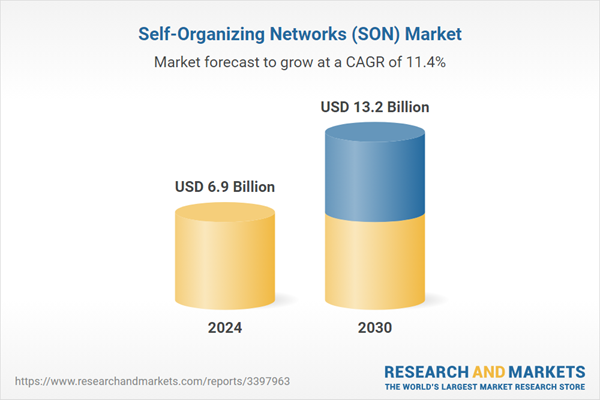The global market for Self-Organizing Networks (SON) was valued at US$6.9 Billion in 2024 and is projected to reach US$13.2 Billion by 2030, growing at a CAGR of 11.4% from 2024 to 2030. This comprehensive report provides an in-depth analysis of market trends, drivers, and forecasts, helping you make informed business decisions. The report includes the most recent global tariff developments and how they impact the Self-Organizing Networks (SON) market.
SON architectures are categorized into three types: distributed, centralized, and hybrid, each offering different advantages depending on the specific requirements of the network. Distributed SONs operate with decentralized control, allowing individual network nodes to autonomously manage themselves, which enhances responsiveness but may lead to suboptimal performance due to lack of coordinated efforts across the network. Centralized SONs manage all operations from a central node, providing cohesive network optimization and configuration but with potentially slower response times. Hybrid SONs blend the benefits of both systems, aiming to optimize both response times and overall control. This adaptability is essential for dynamic enterprise settings, where networks must continuously learn and respond to changes within their environment, a feature facilitated by SONs.
The growth of SON technology is driven by several key factors. As networks become more complex with an increasing number of connected devices and varied data traffic patterns, SONs help manage this complexity by automating network configurations and optimizations. The integration of artificial intelligence and machine learning allows SONs to predict and preemptively address network disruptions, maintaining performance and reliability. Moreover, SONs are crucial in helping network providers comply with stringent quality of service standards imposed by regulatory bodies. The demand for high-speed connectivity and the growing consumer expectations for reliable network service also push network operators towards adopting SONs, which inherently enhance network performance without significant cost increases. Additionally, SONs support the rapid deployment of network services, providing a competitive edge in market responsiveness and flexibility in network management, crucial for adapting to regulatory changes and exploring new network technologies and configurations. As the landscape of network technology evolves, the strategic implementation of SONs will increasingly become vital in managing sophisticated and dynamic network infrastructures effectively.
Segments: Offering (Services, Software); Architecture (Centralized SON (C-SON), Distributed SON (D-SON), Hybrid SON (H-SON)).
Geographic Regions/Countries: World; United States; Canada; Japan; China; Europe (France; Germany; Italy; United Kingdom; and Rest of Europe); Asia-Pacific; Rest of World.
The analysts continuously track trade developments worldwide, drawing insights from leading global economists and over 200 industry and policy institutions, including think tanks, trade organizations, and national economic advisory bodies. This intelligence is integrated into forecasting models to provide timely, data-driven analysis of emerging risks and opportunities.
Global Self-Organizing Networks (SON) Market - Key Trends and Drivers Summarized
Self-organizing networks (SONs) are a significant advancement in network technology, providing substantial benefits in automation, efficiency, and adaptability. Designed to streamline the deployment and management of network infrastructures, SONs automate numerous functions such as planning, configuration management, optimization, and healing, thus simplifying network administration. These networks implement self-configuring, self-optimizing, self-healing, and self-protecting capabilities through advanced technologies like artificial intelligence, predictive analytics, and sophisticated software algorithms. Such automation enables SONs to automatically integrate new access points, adjust operational parameters of base stations to sustain service quality under varying conditions, and swiftly recover from hardware failures, thereby minimizing service disruptions and enhancing network security.SON architectures are categorized into three types: distributed, centralized, and hybrid, each offering different advantages depending on the specific requirements of the network. Distributed SONs operate with decentralized control, allowing individual network nodes to autonomously manage themselves, which enhances responsiveness but may lead to suboptimal performance due to lack of coordinated efforts across the network. Centralized SONs manage all operations from a central node, providing cohesive network optimization and configuration but with potentially slower response times. Hybrid SONs blend the benefits of both systems, aiming to optimize both response times and overall control. This adaptability is essential for dynamic enterprise settings, where networks must continuously learn and respond to changes within their environment, a feature facilitated by SONs.
The growth of SON technology is driven by several key factors. As networks become more complex with an increasing number of connected devices and varied data traffic patterns, SONs help manage this complexity by automating network configurations and optimizations. The integration of artificial intelligence and machine learning allows SONs to predict and preemptively address network disruptions, maintaining performance and reliability. Moreover, SONs are crucial in helping network providers comply with stringent quality of service standards imposed by regulatory bodies. The demand for high-speed connectivity and the growing consumer expectations for reliable network service also push network operators towards adopting SONs, which inherently enhance network performance without significant cost increases. Additionally, SONs support the rapid deployment of network services, providing a competitive edge in market responsiveness and flexibility in network management, crucial for adapting to regulatory changes and exploring new network technologies and configurations. As the landscape of network technology evolves, the strategic implementation of SONs will increasingly become vital in managing sophisticated and dynamic network infrastructures effectively.
Report Scope
The report analyzes the Self-Organizing Networks (SON) market, presented in terms of units. The analysis covers the key segments and geographic regions outlined below.Segments: Offering (Services, Software); Architecture (Centralized SON (C-SON), Distributed SON (D-SON), Hybrid SON (H-SON)).
Geographic Regions/Countries: World; United States; Canada; Japan; China; Europe (France; Germany; Italy; United Kingdom; and Rest of Europe); Asia-Pacific; Rest of World.
Key Insights:
- Market Growth: Understand the significant growth trajectory of the Services segment, which is expected to reach US$8.8 Billion by 2030 with a CAGR of a 12.7%. The Software segment is also set to grow at 9.1% CAGR over the analysis period.
- Regional Analysis: Gain insights into the U.S. market, valued at $1.9 Billion in 2024, and China, forecasted to grow at an impressive 10.3% CAGR to reach $2.0 Billion by 2030. Discover growth trends in other key regions, including Japan, Canada, Germany, and the Asia-Pacific.
Why You Should Buy This Report:
- Detailed Market Analysis: Access a thorough analysis of the Global Self-Organizing Networks (SON) Market, covering all major geographic regions and market segments.
- Competitive Insights: Get an overview of the competitive landscape, including the market presence of major players across different geographies.
- Future Trends and Drivers: Understand the key trends and drivers shaping the future of the Global Self-Organizing Networks (SON) Market.
- Actionable Insights: Benefit from actionable insights that can help you identify new revenue opportunities and make strategic business decisions.
Key Questions Answered:
- How is the Global Self-Organizing Networks (SON) Market expected to evolve by 2030?
- What are the main drivers and restraints affecting the market?
- Which market segments will grow the most over the forecast period?
- How will market shares for different regions and segments change by 2030?
- Who are the leading players in the market, and what are their prospects?
Report Features:
- Comprehensive Market Data: Independent analysis of annual sales and market forecasts in US$ Million from 2024 to 2030.
- In-Depth Regional Analysis: Detailed insights into key markets, including the U.S., China, Japan, Canada, Europe, Asia-Pacific, Latin America, Middle East, and Africa.
- Company Profiles: Coverage of players such as Airhop Communications, Airspan Networks, Inc., AMDOCS Ltd., BLiNQ Networks, Inc., Bwtech and more.
- Complimentary Updates: Receive free report updates for one year to keep you informed of the latest market developments.
Some of the 21 companies featured in this Self-Organizing Networks (SON) market report include:
- Airhop Communications
- Airspan Networks, Inc.
- AMDOCS Ltd.
- BLiNQ Networks, Inc.
- Bwtech
- Casa Systems, Inc.
- Cellwize Wireless Technologies
- Cisco Systems, Inc.
- Comarch SA
- CommScope, Inc.
- Connectors Cables Specialists Ltd.
- Huawei Technologies Co., Ltd.
- NEC Corporation
- Nokia Corporation
- P.I. Works, Inc.
- Qualcomm Inc.
- Rohde & Schwarz GmbH & Co. KG
- Telefonaktiebolaget LM Ericsson
- TEOCO Corporation
- Viavi Solutions, Inc.
Tariff Impact Analysis: Key Insights for 2025
Global tariff negotiations across 180+ countries are reshaping supply chains, costs, and competitiveness. This report reflects the latest developments as of April 2025 and incorporates forward-looking insights into the market outlook.The analysts continuously track trade developments worldwide, drawing insights from leading global economists and over 200 industry and policy institutions, including think tanks, trade organizations, and national economic advisory bodies. This intelligence is integrated into forecasting models to provide timely, data-driven analysis of emerging risks and opportunities.
What’s Included in This Edition:
- Tariff-adjusted market forecasts by region and segment
- Analysis of cost and supply chain implications by sourcing and trade exposure
- Strategic insights into geographic shifts
Buyers receive a free July 2025 update with:
- Finalized tariff impacts and new trade agreement effects
- Updated projections reflecting global sourcing and cost shifts
- Expanded country-specific coverage across the industry
Table of Contents
I. METHODOLOGYII. EXECUTIVE SUMMARY2. FOCUS ON SELECT PLAYERSIII. MARKET ANALYSISIV. COMPETITION
1. MARKET OVERVIEW
3. MARKET TRENDS & DRIVERS
4. GLOBAL MARKET PERSPECTIVE
UNITED STATES
CANADA
JAPAN
CHINA
EUROPE
FRANCE
GERMANY
ITALY
UNITED KINGDOM
REST OF EUROPE
ASIA-PACIFIC
REST OF WORLD
Companies Mentioned (Partial List)
A selection of companies mentioned in this report includes, but is not limited to:
- Airhop Communications
- Airspan Networks, Inc.
- AMDOCS Ltd.
- BLiNQ Networks, Inc.
- Bwtech
- Casa Systems, Inc.
- Cellwize Wireless Technologies
- Cisco Systems, Inc.
- Comarch SA
- CommScope, Inc.
- Connectors Cables Specialists Ltd.
- Huawei Technologies Co., Ltd.
- NEC Corporation
- Nokia Corporation
- P.I. Works, Inc.
- Qualcomm Inc.
- Rohde & Schwarz GmbH & Co. KG
- Telefonaktiebolaget LM Ericsson
- TEOCO Corporation
- Viavi Solutions, Inc.
Table Information
| Report Attribute | Details |
|---|---|
| No. of Pages | 193 |
| Published | April 2025 |
| Forecast Period | 2024 - 2030 |
| Estimated Market Value ( USD | $ 6.9 Billion |
| Forecasted Market Value ( USD | $ 13.2 Billion |
| Compound Annual Growth Rate | 11.4% |
| Regions Covered | Global |









